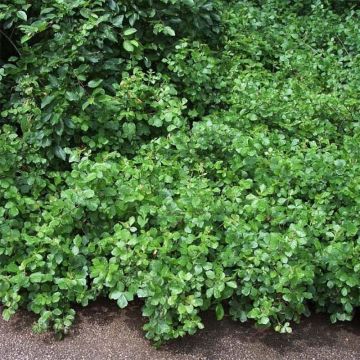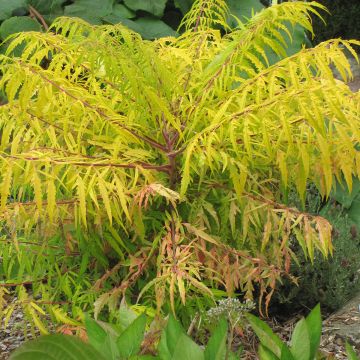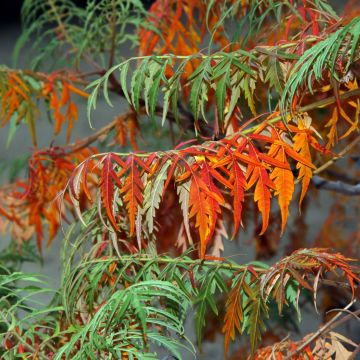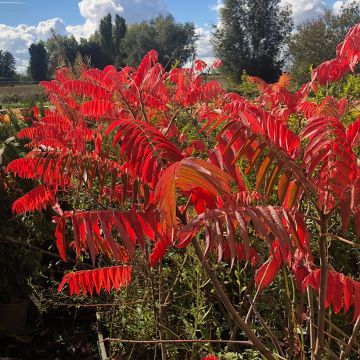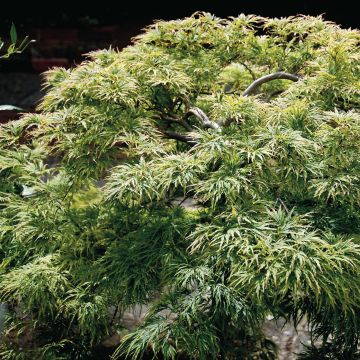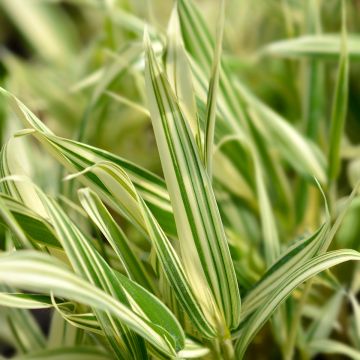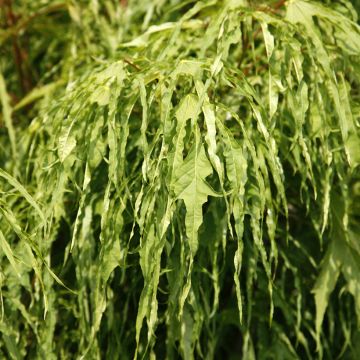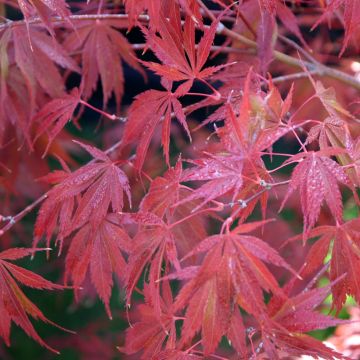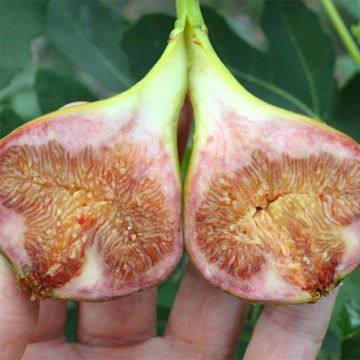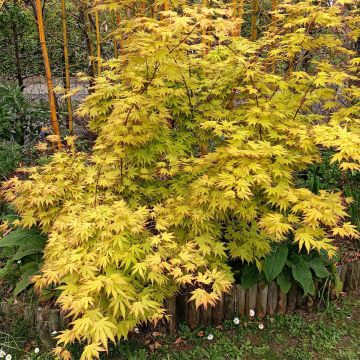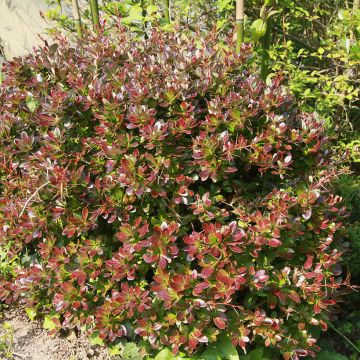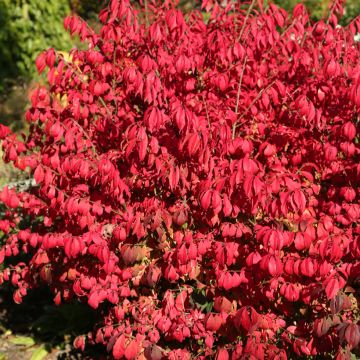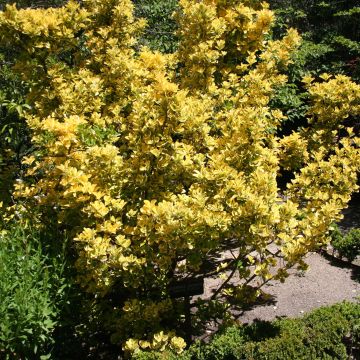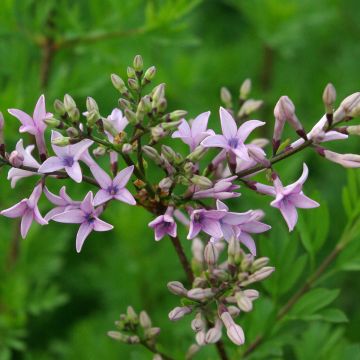

Rhus typhina Dissecta
Rhus typhina Dissecta
Staghorn Sumac, Velvet Sumac
This item cannot be shipped to the selected country
Delivery charge from €5.90
Delivery to Corse prohibited
More information
Schedule delivery date,
and select date in basket
This plant carries a 24 months recovery warranty
More information
We guarantee the quality of our plants for a full growing cycle, and will replace at our expense any plant that fails to recover under normal climatic and planting conditions.
From €5.90 for pickup delivery and €6.90 for home delivery
Express home delivery from €8.90.
Delivery to Corse prohibited: UE law prohibits the import of this plant from mainland France to Corse as part of the fight against Xylella fastidiosa. Please accept our sincere apologies.
More information

Does this plant fit my garden?
Set up your Plantfit profile →
Description
The Rhus typhina 'Dissecta', also known as Virginia cutleaf sumac, is a relatively recent cultivar that was awarded by the Royal Horticultural Society (RHS) of London in 1993. It is a decorative shrub in all seasons with its beautiful compound foliage with deeply dissected leaflets, resembling some ferns. Green during the growing season, it turns magnificent shades of orange and red in autumn before dropping its leaves. The summer flowers develop into long upright reddish spikes, which remain decorative long after the leaves have fallen. Despite its exotic appearance, this spreading shrub is hardy. It adapts well to almost all growing conditions, in well-drained soil, in sunny or partially shaded positions.
The Virginia cutleaf sumac 'Dissecta' belongs to the Anacardiaceae family. It is a plant family mainly represented in the Mediterranean region (with pistachio trees and Cotinus) and in tropical regions (with mango trees). The Virginia cutleaf sumac (or amaranth sumac, or vinegar tree) is native to the eastern United States, where it grows from Georgia to Canada. Therefore, it is not afraid of cold weather. This species was introduced to Europe very early, at the beginning of the 17th century, for its great ornamental qualities. However, it has proven to be quite invasive, as the plants tend to sucker and cover the available surface around them. It is therefore preferable to avoid the species and choose a less suckering variety like 'Dissecta'.
Although the Virginia cutleaf sumac 'Dissecta' does produce suckers every year, they can simply be cut to prevent its spread. This shrub has a fast growth and reaches a mature height of 2.5 m (8 ft 2 in) with a width of 3 m. It has a rounded habit with sparsely branched branches. Its deciduous foliage is enchanting: its large pinnate leaves, 30 to 50 cm (11.8 to 19.7 in) long, are deeply incised into leaflets. They are green during the growing season and turn beautiful autumnal colours, including orange, red, and even purple. The flowering occurs in the form of dense conical panicles that are greenish and terminal, measuring 16 to 25 cm (6.3 to 9.8 in) in length. It takes place in June-July. This shrub is attractive to bees, and the female trees bear intensely red drupes in wine-red clusters, measuring 15 cm (5.9 in) in length. The stems, covered with reddish-brown velvet, are sparsely branched, giving this small tree a graphic and original appearance in winter. This sumac can be planted in any well-drained soil, even limestone or poor, rocky, dry, or moist soil. It thrives in partial shade or full sun, but it is commonly accepted that the autumnal colours will be more intense with a sunny position, as the shrub needs at least six hours of direct sunlight per day. This shrub is not very susceptible to insects or diseases, highly frost-resistant (-25°C), drought-tolerant once established, and tolerant of pollution or sea spray.
The Virginia cutleaf sumac 'Dissecta' provides light shade and can shelter a perennial plant bed with daylilies, brunneras, and can be associated with squills, snowdrops, and daffodils for spring, or cyclamen for autumn. In a small garden, it will be well highlighted if planted as a solitary specimen, providing a changing spectacle on its own. It will also be very interesting in a mixed border with other exotic-looking plants, such as Tetrapanax papyrifera 'Rex' with its huge leaves (to be planted with a rhizome barrier).
The branches of Rhus typhina contain a toxic milky sap. It is used in homeopathy but can cause asthma and allergies. The fruits can be soaked in water to obtain a refreshing and tangy drink (hence its common name of vinegar tree). Birds are fond of its fruits.
Report an error about the product description
Rhus typhina Dissecta in pictures




Plant habit
Flowering
Foliage
Botanical data
Rhus
typhina
Dissecta
Anacardiaceae
Staghorn Sumac, Velvet Sumac
Cultivar or hybrid
Other Rhus - Sumac
Planting and care
Plant the Rhus typhina 'Dissecta' in any soil, even chalky and poor, rocky, dry or moist, but well-drained. It will thrive in partial shade or in the sun, but it is commonly accepted that the autumn colours will be more intense with a well-sunlit exposure, the bush needing at least six hours of direct sunlight per day. A wind-sheltered exposure will be preferable to preserve the foliage. Without pruning, this sumac naturally takes on the appearance of a small tree. To maintain a beautiful habit, it may be necessary to remove dead wood or tangled branches. Pruning should be done before the start of vegetation (from February to April). This variety produces fewer suckers than the species. Therefore, it is sufficient to monitor the appearance of suckers under the plant and eliminate them without difficulty.
Planting period
Intended location
Care
This item has not been reviewed yet - be the first to leave a review about it.
Striking foliage shrubs
Haven't found what you were looking for?
Hardiness is the lowest winter temperature a plant can endure without suffering serious damage or even dying. However, hardiness is affected by location (a sheltered area, such as a patio), protection (winter cover) and soil type (hardiness is improved by well-drained soil).

Photo Sharing Terms & Conditions
In order to encourage gardeners to interact and share their experiences, Promesse de fleurs offers various media enabling content to be uploaded onto its Site - in particular via the ‘Photo sharing’ module.
The User agrees to refrain from:
- Posting any content that is illegal, prejudicial, insulting, racist, inciteful to hatred, revisionist, contrary to public decency, that infringes on privacy or on the privacy rights of third parties, in particular the publicity rights of persons and goods, intellectual property rights, or the right to privacy.
- Submitting content on behalf of a third party;
- Impersonate the identity of a third party and/or publish any personal information about a third party;
In general, the User undertakes to refrain from any unethical behaviour.
All Content (in particular text, comments, files, images, photos, videos, creative works, etc.), which may be subject to property or intellectual property rights, image or other private rights, shall remain the property of the User, subject to the limited rights granted by the terms of the licence granted by Promesse de fleurs as stated below. Users are at liberty to publish or not to publish such Content on the Site, notably via the ‘Photo Sharing’ facility, and accept that this Content shall be made public and freely accessible, notably on the Internet.
Users further acknowledge, undertake to have ,and guarantee that they hold all necessary rights and permissions to publish such material on the Site, in particular with regard to the legislation in force pertaining to any privacy, property, intellectual property, image, or contractual rights, or rights of any other nature. By publishing such Content on the Site, Users acknowledge accepting full liability as publishers of the Content within the meaning of the law, and grant Promesse de fleurs, free of charge, an inclusive, worldwide licence for the said Content for the entire duration of its publication, including all reproduction, representation, up/downloading, displaying, performing, transmission, and storage rights.
Users also grant permission for their name to be linked to the Content and accept that this link may not always be made available.
By engaging in posting material, Users consent to their Content becoming automatically accessible on the Internet, in particular on other sites and/or blogs and/or web pages of the Promesse de fleurs site, including in particular social pages and the Promesse de fleurs catalogue.
Users may secure the removal of entrusted content free of charge by issuing a simple request via our contact form.
The flowering period indicated on our website applies to countries and regions located in USDA zone 8 (France, the United Kingdom, Ireland, the Netherlands, etc.)
It will vary according to where you live:
- In zones 9 to 10 (Italy, Spain, Greece, etc.), flowering will occur about 2 to 4 weeks earlier.
- In zones 6 to 7 (Germany, Poland, Slovenia, and lower mountainous regions), flowering will be delayed by 2 to 3 weeks.
- In zone 5 (Central Europe, Scandinavia), blooming will be delayed by 3 to 5 weeks.
In temperate climates, pruning of spring-flowering shrubs (forsythia, spireas, etc.) should be done just after flowering.
Pruning of summer-flowering shrubs (Indian Lilac, Perovskia, etc.) can be done in winter or spring.
In cold regions as well as with frost-sensitive plants, avoid pruning too early when severe frosts may still occur.
The planting period indicated on our website applies to countries and regions located in USDA zone 8 (France, United Kingdom, Ireland, Netherlands).
It will vary according to where you live:
- In Mediterranean zones (Marseille, Madrid, Milan, etc.), autumn and winter are the best planting periods.
- In continental zones (Strasbourg, Munich, Vienna, etc.), delay planting by 2 to 3 weeks in spring and bring it forward by 2 to 4 weeks in autumn.
- In mountainous regions (the Alps, Pyrenees, Carpathians, etc.), it is best to plant in late spring (May-June) or late summer (August-September).
The harvesting period indicated on our website applies to countries and regions in USDA zone 8 (France, England, Ireland, the Netherlands).
In colder areas (Scandinavia, Poland, Austria...) fruit and vegetable harvests are likely to be delayed by 3-4 weeks.
In warmer areas (Italy, Spain, Greece, etc.), harvesting will probably take place earlier, depending on weather conditions.
The sowing periods indicated on our website apply to countries and regions within USDA Zone 8 (France, UK, Ireland, Netherlands).
In colder areas (Scandinavia, Poland, Austria...), delay any outdoor sowing by 3-4 weeks, or sow under glass.
In warmer climes (Italy, Spain, Greece, etc.), bring outdoor sowing forward by a few weeks.

































